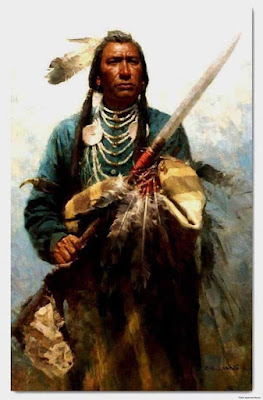The Sacred Bear-Spear
The Sacred Bear-Spear
Many generations ago, even before the Blackfeet used horses as beasts of burden, the tribe was undertaking its autumn migration, when one evening before striking camp for the night it was reported that a dog-sledge or cart belonging to the chief was missing.
To make matters worse, the chief's ermine robe and his wife's buckskin dress, with her sacred elk-skin robe, had been packed in the little cart.
Strangely enough, no one could recollect having noticed the dog during the march.
Messengers were dispatched to the camping-site of the night before, but to no avail.
At last the chief's son, Sokumapi, a boy about twelve years of age, begged to be allowed to search for the missing dog, a proposal to which his father, after some demur, consented.
Sokumapi set out alone for the last camping-ground, which was under the shadows of the Rocky Mountains, and carefully examined the site.
Soon he found a single dog-sledge track leading into a deep gulch, near the entrance to which he discovered a large cave.
A heap of freshly turned earth stood in front of the cave, beside which was the missing cart.
As he stood looking at it, wondering what had become of the dog which had drawn it, an immense grizzly-bear suddenly dashed out.
So rapid was its attack that Sokumapi had no chance either to defend himself or to take refuge in flight.
The bear, giving vent to the most terrific roars, dragged him into the cave, hugging him with such force that he fainted.
When he regained consciousness it was to find the bear's great head within a foot of his own, and he thought that he saw a kindly and almost human expression in its big brown eyes.
For a long time he lay still, until at last, to his intense surprise, the Bear broke the silence by addressing him in human speech.
"Have no fear," said the grizzly.
"I am the Great Bear, and my power is extensive.
I know the circumstances of your search, and I have drawn you to this cavern because I desired to assist you.
Winter is upon us, and you had better remain with me during the cold season, in the course of which I will reveal to you the secret of my supernatural power."
It will be observed that the circumstances of this tale are almost identical with those which relate to the manner in which the Beaver Medicine was revealed to mankind.
The hero of both stories remains during the winter with the animal, the chief of its species, who in the period of hibernation instructs him in certain potent mysteries.
The Bear, having reassured Sokumapi, showed him how to transform various substances into food.
His strange host slept during most of the winter; but when the warm winds of spring returned and the snows melted from the hills the grizzly became restless, and told Sokumapi that it was time to leave the cave.
Before they quitted it, however, he taught the lad the secret of his supernatural power.
Among other things, he showed him how to make a Bear-spear.
He instructed him to take a long stick, to one end of which he must secure a sharp point, to
symbolize the bear's tusks.
To the staff must be attached a bear's nose and teeth, while the rest of the spear was to be covered with bear's skin, painted the sacred color, red.
The Bear also told him to decorate the handle with eagle's feathers and grizzly claws, and in
war-time to wear a grizzly claw in his hair, so that the strength of the Great Bear might go with him in battle, and to imitate the noise a grizzly makes when it charges.
The Bear furthermore instructed him what songs should be used in order to heal the sick, and how to paint his face and body so that he would be invulnerable in battle, and, lastly, told him of the sacred nature of the spear, which was only to be employed in warfare and for curing disease.
Thus if a person was sick unto death, and a relative purchased the Bear-spear, its supernatural power would restore the ailing man to health.
Equipped with this knowledge, Sokumapi returned to his people, who had long mourned him as dead.
After a feast had been given to celebrate his home-coming he began to manufacture the Bear-spear as directed by his friend.
Shortly after his return the Crows made war upon the Blackfeet, and on the meeting of the two tribes in battle Sokumapi appeared in front of his people carrying the Bear-spear on his back.
His face and body were painted as the Great Bear had instructed him, and he sang the battle-songs that the grizzly had taught him.
After these ceremonies he impetuously charged the enemy, followed by all his braves in a solid phalanx, and such was the efficacy of the Bear magic that the Crows immediately took to flight.
The victorious Blackfeet brought back Sokumapi to their camp in triumph, to the accompaniment of the Bear songs.
He was made a war-chief, and ever afterward the spear which he had used was regarded as the palladium of the Blackfoot Indians.
In the spring the Bear-spear is unrolled from its covering and produced when the first thunder is heard, and when the Bear begins to quit his winter quarters; but when the Bear returns to his den to hibernate the spear is once more rolled up and put away.
The greatest care is taken to protect it against injury.
It has a special guardian, and no woman is permitted to touch it











Comments
Post a Comment